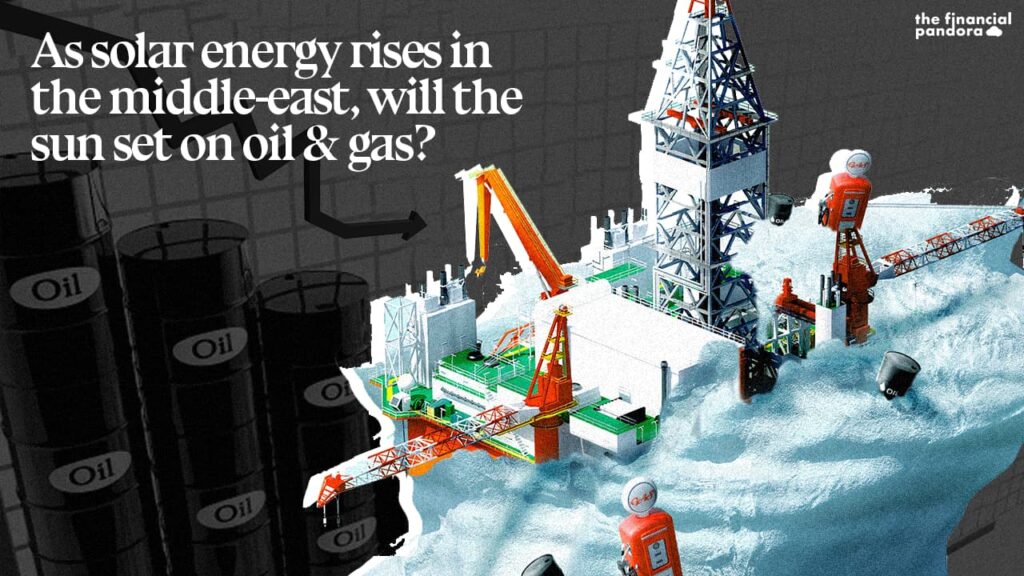The Middle East and Oil have been associated together due to the Middle East controlling the majority of the oil production1 in the world. A quarter of Middle East powers comes from this oil. One thing that always disappears in this association of Middle East countries with oil is the vast deserts in the Middle East who receive abundant sunshine, making solar energy an attractive option to shift from Oil. While the non-oil producing countries like Morocco have already pushed towards renewable energy with one third of its energy coming from Solar power. To put this into perspective, the average power generation around European countries is 18% from solar.
With the recent oil price crashes, major oil producing countries are also catching up to this trend, with Abu Dhabi securing the world’s lowest tariff for a solar power plant. The scheduled 2 GW Al-Dafra plant in Abu Dhabi reportedly received a bid of just 1.35 US cents per kilowatt hour. This plant will produce enough power for nearly 16,000 households which would reduce the carbon emissions by more than 1.5 million metric tons a year. To put this into perspective, it will be equivalent to removing nearly 500,000 cars from the road This is just one of the low tariff projects scheduled to happen in the Middle East with countries like Qatar and Saudi Arabia also announcing solar projects which will produce more than 1 GW of energy. Currently, the Middle East just produces 9 GW of solar power which is substantially higher than 91 megawatts of energy produced by this region a decade ago. The investments in the renewable energy sector in the Middle East have increased tenfold, thanks to governments (trying to move away from oil which is the major part of their revenue) and favourable weather conditions.

According to the recent reports by Bloomberg NEF (New Energy Finance), Solar PV and onshore wind are the cheapest electricity option for two thirds of the population and according to the report, the price will further reduce due to new innovations and subsidies offered by different governments to reach their climate neutrality goals. The innovations coupled with government intervention has led to a tremendous growth of renewables all over the world with the United States announcing that for the first time in 130 years the energy produced by renewables was more than what was produced by Coal. The consumption of coal was down by 15% in 2019 while there was a significant growth in the consumption of solar and wind energy. Some parts of the world are going a step up further like the European Union, which announced plans to go all renewable i.e. reach climate neutrality by the year 2050. The recent European recovery plan had “European Green Deal” at the heart, informing countries that any investment that harms their goals of climate neutrality will be stopped.
So is everything going according to the Plan?
Various analysts suggest that maintaining a solar farm in the Middle East will be cheaper than maintaining an oil and gas plant. There are talks in Abu Dhabi to start exporting the solar energy they produce to other countries. While all these show signs of optimism that Middle East might turn a leaf, but looking at the past of some of these countries, we have to be vary before thinking there will be a shift in investments from oil to renewables. Middle East is not a democratic region, it is run by autocrats who often promise more than they can deliver. Take Muhammad Bin Salman or as the world likes to call him MSB, the poster child of the future of Middle East. In 2018, MSB announced a project with SoftBank for a solar power generation in Saudi Arabia but it was shelved just 6 months later. With the autocrats, comes the frequent regional turmoil which could be another road-block for the regions to switch to renewables. According to Iran’s minister of energy, protests are the reasons for the country’s inability to meet its promise of producing 20% of energy by renewables.
While there are positive signs that the region notorious for burning a lot of oil to meet its lofty ambitions is finally embracing renewable energy and playing a part in preserving the environment, the shift will take ages to happen as with the oil prices crashing, oil-rich countries are producing more oil which will lead to a drop in revenues for oil producing countries forcing them to stop the solar projects. All we could do is hope that the Middle East countries understand that there is no sense in investing money in taking fuel out of the ground and processing it when you can rely on God-given sun and wind.
# 1.The article pertains to Crude Oil.
Follow Us @




